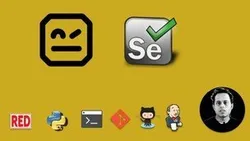
Get in touch with Tricentis Continuous Testing 
Tricentis Continuous Testing provides a comprehensive solution for software testing, allowing users to quickly and efficiently test their applications. Get in touch to learn more. ▼
ADVERTISEMENT
Course Feature
![]() Cost:
Cost:
Free
![]() Provider:
Provider:
Udemy
![]() Certificate:
Certificate:
No Information
![]() Language:
Language:
English
![]() Start Date:
Start Date:
Finished
Course Overview
❗The content presented here is sourced directly from Udemy platform. For comprehensive course details, including enrollment information, simply click on the 'Go to class' link on our website.
Updated in [April 29th, 2023]
This course provides an overview of the Tricentis continuous testing platform. It is designed to help learners identify which Tricentis training courses and learning materials they should use to upskill on the tools and features most relevant to their daily tasks. Learners will gain an understanding of how the software testing process works, and how Tosca Testsuite, qTest Manager, and SAP testing could fit into their role. The course is available as a self-paced online course, and takes less than an hour to complete for each of the 6 roles. Learners can register for free using the voucher code “PlatformIntroduction”. They will need to have a Tricentis Support Portal account for this voucher to work.
[Applications]
After completing this course, it is suggested that users apply their knowledge by enrolling in the relevant Tricentis training courses and learning materials to upskill on the tools and features most relevant to their daily tasks. Additionally, users should take advantage of the free voucher code “PlatformIntroduction” to register for the course.
[Career Paths]
1. Software Tester: Software testers are responsible for ensuring that software applications meet the requirements of the customer. They use a variety of testing techniques to identify and document any bugs or issues in the software. Software testers must have a strong understanding of software development processes and be able to work with developers to ensure that the software meets the customer's needs. The demand for software testers is increasing as more companies move to agile development processes and require more frequent testing.
2. Automation Tester: Automation testers are responsible for creating and executing automated tests to ensure that software applications meet the customer's requirements. Automation testers must have a strong understanding of software development processes and be able to work with developers to ensure that the software meets the customer's needs. Automation testing is becoming increasingly popular as companies move to agile development processes and require more frequent testing.
3. Performance Tester: Performance testers are responsible for ensuring that software applications meet the performance requirements of the customer. They use a variety of testing techniques to identify and document any performance issues in the software. Performance testers must have a strong understanding of software development processes and be able to work with developers to ensure that the software meets the customer's needs. The demand for performance testers is increasing as more companies move to agile development processes and require more frequent testing.
4. Security Tester: Security testers are responsible for ensuring that software applications meet the security requirements of the customer. They use a variety of testing techniques to identify and document any security issues in the software. Security testers must have a strong understanding of software development processes and be able to work with developers to ensure that the software meets the customer's needs. The demand for security testers is increasing as more companies move to agile development processes and require more frequent testing.
[Education Paths]
The recommended degree paths for learners of this course are:
1. Bachelor of Science in Software Engineering: This degree path provides students with the knowledge and skills to design, develop, and maintain software systems. It covers topics such as software development, software engineering principles, software testing, and software project management. Students will also learn about the latest trends in software engineering, such as cloud computing, artificial intelligence, and machine learning.
2. Master of Science in Computer Science: This degree path provides students with the knowledge and skills to design, develop, and maintain computer systems. It covers topics such as computer architecture, algorithms, data structures, operating systems, computer networks, and software engineering. Students will also learn about the latest trends in computer science, such as artificial intelligence, machine learning, and blockchain technology.
3. Master of Science in Information Technology: This degree path provides students with the knowledge and skills to design, develop, and maintain information systems. It covers topics such as database design, web development, network security, and software engineering. Students will also learn about the latest trends in information technology, such as cloud computing, big data, and the Internet of Things.
4. Doctor of Philosophy in Computer Science: This degree path provides students with the knowledge and skills to design, develop, and maintain computer systems. It covers topics such as computer architecture, algorithms, data structures, operating systems, computer networks, and software engineering. Students will also learn about the latest trends in computer science, such as artificial intelligence, machine learning, and blockchain technology.
Pros & Cons

Shows lots of possibilities to manage testing activities

Clear voice

Accessible to most users

Very helpful to a learner

Basic overview of how to use each section in Tosca

Short segments and not too much detail

Certain "how to" parts not explained

Wording on some questions confusing

Contents not explained in depth
Course Provider

Provider Udemy's Stats at AZClass
Discussion and Reviews
0.0 (Based on 0 reviews)
Explore Similar Online Courses

Billy Collins Teaches Reading And Writing Poetry

Introduction to Advance Features in Rasa Chatbot Framework 2

Python for Informatics: Exploring Information

Social Network Analysis

Introduction to Systematic Review and Meta-Analysis

The Analytics Edge

DCO042 - Python For Informatics

Causal Diagrams: Draw Your Assumptions Before Your Conclusions

Whole genome sequencing of bacterial genomes - tools and applications

Boost Your Game Performance in Unity 3D

ISTQB Certified Tester Foundation Level Training (CTFL)


Start your review of Get in touch with Tricentis Continuous Testing